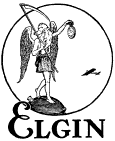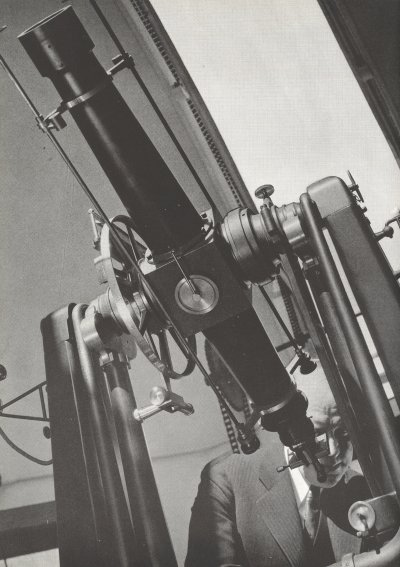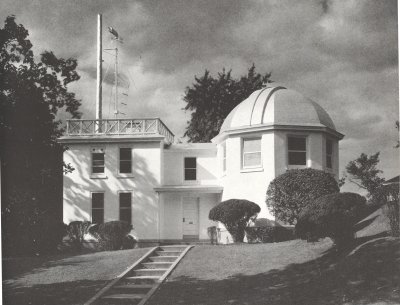Time of Stars is Elgin Guide, Part 1

Time of Stars is Elgin Guide, Part 1 |

|

|
The Watch Word,
|
|||
|
Crouched attentively upon the top of a small hill a short distance from the factory of the Elgin National Watch company in the city of Elgin, there stands the Observatory building. |
||||
|
Constantly vigilant, its instruments search the heavens in its routine of finding checks and balances with which to shackle basic time and of transforming the unerring time yielded by the stars into time adapted to mundane practices and understanding. The Observatory stands as a Sentiel of Precision who sees to it that the passage of fixed star images across the meridian is recorded and that an exact split infinitesimal fraction of the moment of that passage is transformed and transmitted through precision instruments to the thousands of watches which each day stream from the factory to people of all sorts in the daily walks of life. |

|
|||
|
This Observatory is an important factor in the manufacture of watches. To achieve accuracy the pulsations, beats or ticks of a watch must conform precisely with the intervals of time it measures. The rate of these pulsations must be adjusted so a basic time control of accuracy will ensue. Lack of facilities with which to provide timing precision introduces a factor of guesswork in watch manufacture. Elgin Alone Has ObservatoryIt is of significance, then, that the Elgin company is the only manufacturer of watches in America which maintains such facilities. The importance of the Observatory in watchmaking may need additional and extended explanation, and in some detail. A watch, as is known, is an instrument for measuring intervals of time. In order to measure anything, it is necessary that there be a comprehensible unit of measurement which is constant. In the simple measurements of fluids, for instance, the pint is a fixed unit or standard. To measure time it is thus necessary to find a fixed and unchangeable unit which always recurs in exactly the same interval. . """I! Science has ascertained that the most constant, unchanging motion in the universe is the rotation of the earth upon its axis. This action is so regular that it does not vary in its repetition a one-hundredth of a second in 1,000 years. Earth Itself The Perfect ClockThe earth thus becomes the perfect clock. It completes one rotation in each of the intervals we know as a day. The trouble with it as a timepiece is that it has no hands nor no hour marks ranged around its face. The elementary division of the day however, is easily distinguished as our day and night. But beyond that some other way had to be found if it was expected that the world was to tell time. For centuries the scholars worked on the problem of breaking down the diurnal unit into provable hours, minutes and seconds. After Gallileo gave the world . the telescope, considerable progd:ess was made. Fixed stars were located '''lhd mathematics applied. The way was found to check the earth's position in relation to a fixed star. Other fixed stars were found. Means were found to record the moment at which a star was exactly above a given point upon earth. The next time the star and earth were in exactly the same position an unalterable day had gone by. From that point it was comparatively easy. That is, excepting for the fact that the sun's performances didn't coincide with the rules of the stars and the day and night divisions got confused. Sun and Stars at VarianceA year consists of 366.24 star or sidereal days. It also consists of 365.24 mean solar days. This means that the mean solar day is three minutes and 56.555 seconds longer than the sidereal day-a total of twenty-four hours longer each year. The solar day is based on the relation of the earth to the sun. As the earth rotates on its axis it also revolves around the sun. The time lapsing between the passings of the sun across a given meridian on earth is a solar day. Owing to a change in related positions of the earth's surface with the sun, in the orbital performance, (elliptical in form), the ~ays and nights are of varying and unequal length. To ccu-rect this situation a fictitious sun has been created with which a straight 24-hour (or mean) day is made possible all year around. As a matter of fact this acceptance of a standard time year is a compromise between the rotations of the earth as viewed from the fixed stars and the somewhat hip-swung and swing-time revolutions of the earth around the sun. The time of the revolution around the sun is set at one year, and the daily rotations as the distant stars see them are fitted into that period. Through leap-year and other corrections the mean solar day is kept in line with the star time. Working Time Unit CreatedThis mean solar day is the standard of time now accepted. By dividing the earth into twenty-four longitudinal sections the day is established at 24 hours. in the interest of uniformity it is agreed that when the sun appears vertically above a certain meridian the time will be regarded at 12 o'clock, noon. If it is 12 o'clock at the first meridian it will not be 12 o'clock at the next until that line moves under the sun center, and so on. This establishes a common gauge of the passage of time but there is no way of checking the measurement of such time excepting by star positions. That is where the work of the Observatory comes in. Through the centuries the mathematicians and other scientists have managed to strait-jacket the intervals of movement which positively characterize the heavenly bodies within the ken of men - or at least man's telescope. Through this procedure he has devised an orderly measuring system on earth which has been applied to all the important as well as commonplace activities of humanity, technology, the lower animals, the earth's surface and that which is underneath. Time Invades All ActionsIn other words, every conceivable "inkle" of habit or reflex of the animate or inanimate, has come to bear some relation with the element of time. The tides of the ocean rise and fall on time, volcanos spew by time, geysers emit by time, snow falls, ice forms, rains come and railway trains and water carriers move by time; animal life comes into being, worries through the days of its life and then expires on a time schedule. Breathing rates, pulse beats - nearly everything has a time relation. It is because of the interweaving of the time element into every mundane activity that bears on human civilization, that this element has become so important in our day and age. And that is why, in the manufacture of time measuring devices, precision of measure has become so highly important. That is why the Elgin company has ventured into the field of exact science (and Elgin alone, of all watchmakers) and has created means to obtain timing precision from the source. Control Dates to 1908Although the march of progress in time measurement had reached a stage oE eminence by 1908, it was not until that year that the United States government came to regard timing efficiency of such economic importance as to take a hand in its management. At that time President Theodore Roosevelt directed the United States Bureau of Standards to set up tests for watches. The resultant report disclosed that time controls in America were inadequate and something should be done about it. The Elgin company to provide its own accurate time standards announced that it would build an astronomical unit to cover this necessity, and the Observatory was the result. In May, 1909, Professor William W. Payne of Goodsell Observatory, at Carleton College, Northfield, Minnesota, was engaged to advise and assist in locating and equipping the observatory. Because the Elgin company had decided to have the most perfect observatory on the continent, the site on which to locate it was quite a problem. After considerable research and study, the hill at Watch and Raymond streets was chosen because of its gravel which greatly reduces the vibrations of the earth. A temporary building was erected and the transit instruments installed. Observatory Finally is OpenedA permanent building was soon started according to designs made by and supervised by George Hunter, consulting superintendent, to comply with the requirements outlined by Professor Payne. Additional precision clocks were purchased and both the clocks and the telescope were each mounted upon concrete pillars, separate from the building itself, and that run down deep into the gravel bed to reduce vibration to a minimum. The Observatory was opened for business in February, 1910, and Professor Payne's engagement as director was extended indefinitely.
|
||||
|
||||
|
|
||||

|
|
|||
|
|
||||
Comments to jsexton@elgintime.com